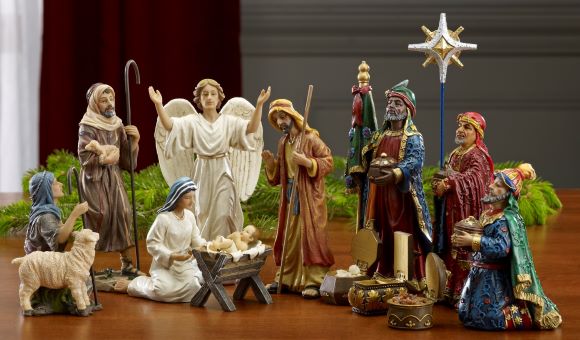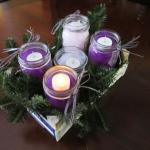ADVENT IS COMING—2 of 4—Things to Do and Not to Do at Home
Advent means “to come to” or “toward” and is filled with a sense of expectation and hope. But most years, we get too busy, scattered, and jaded to allow the season to have a life of its own. In this four-part series, I give a little background and a few ideas that might help you stop, breathe, and become a part of the anticipation of Christmas.
How Much Time DO You Have?
Be honest. We are all busy, especially during the Holidays, with presents to ferret out, buy, and wrap. Parties, get-togethers, and soirees to attend. Pageants, concerts, and recitals abound and take up our precious time. So, how much time can you dedicate to a single practice to enrich your and possibly your family’s life? Be brutally honest. Do not set yourself up to fail. If it’s only five minutes a day.
Set Your Time and Day
I set an alarm on my phone for the same time each day to do my devotionals. I also set a separate notice for Sunday to light the Advent candles. It takes the responsibility off me and puts it where it belongs, on an electronic assistant. So now that you know how much time you have, let’s dig into some fun and fulfilling ways to deepen your Advent walk.
Choose Wisely
The following are different devotionals, practices, readings, and activities you can do to enrich your or your family’s Advent journey. But they come with caution, start small, and grow. Don’t pick all the items and overload your shopping basket with a thousand dollars of goodness. You will already be burning your non-violet and rose candles at both ends during this season. Don’t add to the crazy! This is a time for reflection and peace, not ulcers!
Advent Wreath
An Advent Wreath would be one of my first go-to’s for Advent in the home. Consider it a “home base,” a place of renewal, a port in the storm of the “Shop-mas” season that we all go through. I like to place at least one in the dining area and another in the living space. Why? Because it becomes a natural part of life’s rhythm. You have a Sunday evening meal, and there it is. You can light it before dinner, say an Advent prayer, and suddenly, you join a celestial family of people doing the same thing worldwide. An Advent Wreath in the shared living space is for personal or family devotional time. I usually have a bible or Advent devotional book nearby. The key is having a visual to inspire you and help you find that moment of physical, mental, and spiritual peace. But don’t forget to blow out the candles before you leave the room!
Many times, the candles are lit with an accompanying prayer. Several excellent resources and prayers are the from Blessing of an Advent Wreath | USCCB and Liturgical Year : Prayers : Blessing and Prayers for Advent Wreath | Catholic Culture. A few less formal prayers are found at Advent Wreath Prayers | Dynamic Catholic and Prayers for Advent Wreath at Home – ROMAN CATHOLIC DIOCESE OF CALGARY (catholicyyc.ca).
And the Advent wreath isn’t just for home! Depending on your workplace, why not have one on your desk? Remember, the best prayers are those you come up with on your own! So, give it a try!
Crèche or Nativity Set.
One of my earliest memories of Advent was of an old plaster of Paris Nativity Set my grandmother had under her Christmas tree—minus the baby Jesus in the manger since He hadn’t been born yet. My cousins and I would play for hours with the figurines, setting up scenarios with the sheep and shepherds, the angels visiting, and the kings moving closer and closer to the manger whenever we came to Grandma’s house. The adults would come and check on us from time to time, telling us in their own words what happened that night around 2,000 years ago. It’s a memory that has never left me.
The crèche is a great physical reminder of what this season is about. It shows the everyday bustling life of a community 2,000 years ago and the specialness of that single night. God Himself, coming to inhabit a human form in the lowest possible circumstance—not as a king, a multi-billionaire, or a known influencer. No. He came as the surrogate son of a handyman and a young girl who didn’t have the money or clout to push someone out of their bed for the night. They were homeless and strangers, and the only other visitors they had that night were also menial laborers—shepherds— and God’s messengers. The crèche is a great teaching tool for young and old alike. Let your mind explore! Make it your own!
Christmas Tree
Christmas trees in the house can be a time of stress, allergies, and disruption. But still, most of us wouldn’t be without them. But have you asked yourself why? Is it because you’ve always had one? Maybe nostalgia? Or maybe it’s a status symbol in your window or entryway? Perhaps it’s time to think about why you have a tree in your house over winter—link a little purpose to it.
We have not one, not two, but usually three or four trees in our house over Advent. Why? Because each has a story to tell and a memory to share. We traditionally have one large tree in the living room. This has become our “Memory Tree.” We collect one or two ornaments that embody the year we’ve had—a new job, a vacation, or a family member or friend who has passed—they are all up there. Remember, the Bible is a book of collected and shared memories of the journey of a people coming back to their Creator. In this one tree, we experience our journey as a family over the years.
Another tree is the “Holy Tree.” This tree has a collection of different angelic and nativity ornaments we have collected over the years from friends and family. Under the tree, we have the smaller and more delicate nativity sets in our collection (I’ve lost track of how many nativities we’ve collected. It’s over 20…).
The third tree is a “Thought Tree.” This tree was created when we were a young, broke couple and didn’t have much. It consists of many stir sticks from a local coffee shop with a loop around one end. On the sticks, we’ve written thoughts, inspirations, and questions. Things like, “What was your favorite vacation to date?” or, “What is your favorite childhood Christmas memory?” or “Remember, ‘Do unto others means you need to be kind to yourself first.’” This tree usually lives in an accessible area, like the dining room or a pass-through space, so anyone can take just a few moments to stop, read, and smile with a single thought.
The “Outdoor Tree,” We don’t want to forget about our outdoor friends! We usually have at least one tree outdoors (and yes, with lights!) that has suet balls and bird feeder seed for the birds wintering over in the area. We also put a few nuts and other things for the squirrels and furry friends under the tree to give them a little boost for the winter.
The point is, there are no rules! Create something fun and meaningful for yourself and your family. Don’t forget to pass along your ideas to me and others!
Candles in the Window
This is a tradition starting in 17th century Ireland. It signifies hospitality and is a memorial to the Holy Family on their journey and signifies that they are welcome in your home.
A little personal family history— my mother used to retell the story that during the Depression Advents, it was her job as the youngest—all of eight years old— to light the lamps and candles and then put them in the windows after supper. One night, in the depths of the depression, there was a knock on their farmhouse door. My grandfather answered the door. Before him stood a man and his young wife—dirty, tired, and hungry. The couple was looking for simple kindness. Seeing the candles and lamps in the window, they decided to take a chance. My Grandfather and Grandmother brought them out of the cold and into the house, giving them something to eat and letting them clean themselves. After, they allowed the couple to stay the night in a spare room out back. The couple was gone in the morning, and life went on as usual. My mother asked, “Why did they come to our door, and why did you let them in?” She said my grandfather smiled down at her and said, “Because that’s what the candle means. You never know when Jesus, Mary, or Joseph will walk through your door.”
Today’s society has taken the original idea and embellished it many steps further. We now trace and decorate our houses in lights, put figurines on the lawn and roof, and play music over loudspeakers for the neighborhood and passers-by to hear. But all these things come from the origin of a single candle in the window, showing hospitality to strangers.
Advent Calendars
Advent Calendars play a particular part in history. Initially, they were to mark time as a countdown to Christmas. Along the way, they became a teaching tool and a way to reward children for learning scripture.
We have Advent Calendars in all shapes, sizes, and purposes today. There are traditional calendars with a small candy hidden behind a cardboard door with a picture of a Nativity character or Santa Claus. There are a few old-style Advent calendars on the market now that are simply drawers you can fill with what you like for you and your family. And there are “Advent Beer” and “Advent Wine” calendars that (as advertised) raise the spirits!
My suggestion is to create your own! Make it memorable for you and your family. I created one years ago for my wife and me. I bought 24 different Nativity crèche figurines and built a little stand with 24 drawers in the base. I then placed a figurine in each drawer with a small prize—a chocolate, a little toy, a lip balm—and put in a little three or four-sentence story of the figurine. It went like this: “My name is Poly, and I’m a sheep. I like to frolic and jump around the pasture. I know I’ll grow up someday, but I enjoy following the shepherd around. I’m not like my brother—he’s the black sheep. I heard the angels singing the other night, but I didn’t know what they said.”
The key is to make your calendar unique and specific to something that brings you back to counting down to Christmas and something that you and your family will enjoy.
Devotionals and Readings
This can be a very gratifying thing, or something that will turn you and your family off for good, so be judicious and honest with yourself and your family. Change it if it becomes a chore and you’re not getting anything out of it! It’s YOUR practice, no one else’s! Find something that has meaning and helps you find peace. It’s like shopping for the right sweater—experiment, search, and try things on.
Devotionals and Readings are not just biblical passages. No. They can be pieces of music, good stories that bring you closer to the meaning of Christmas, and, yes, Biblical stories and passages. Again, be judicious. Don’t trap yourself in things that will only frustrate you or cause more work you don’t have time for. There are hundreds of good devotionals for any age online or at any bookstore. Experiment, search, and make it your own time.
Cleaning
I know, I know… The last thing you want to do is clean the house when you have all these other things to worry about! But if you clean with intent, it can also become an Advent Practice. Cleaning can have several purposes. First, you get a clean house, and that’s always a bonus.
Start with one room, and one room only. Be intentional. Which room, after it’s cleaned, makes you feel the most at peace? The Bathroom? The Bedroom? The Closet? Pick the room that makes you go, “Ah…” when it’s clean. Then, think about what’s important to keep and what you can let go. Science has shown the fewer things we have cluttering our lives, the calmer and more at peace we feel. Ask yourself, “Do I really need seven green sweaters of all the same shade?” “Can I do without the nine hairbrushes and six hair product bottles?” “Do I really have room for 14 pairs of sheets?”
Don’t just throw away the things you are liberating from your life. Think about each thing and ask if someone else could use it to make their lives better. If so, then you can do a couple things. You can: a) ask people you know if they would have any use for the objects, b) put them up for sale for free through a community website, or c) donate them to a thrift store in your area. Again, be creative!
After cleaning, downsizing, and straightening one room, stop. Look at the room and soak in the feeling of accomplishment. You have created order out of disorder. You have pared away things that are no longer necessary in your life. You have started a new outlook on a new year with all the cobwebs of the past swept away. You can now invite the peace and harmony of the Christ Child into your life.
Do this for as many rooms in your living space as possible over the holiday. But do only one room a day. No blitzing! Extend this cleaning practice throughout Advent, and it will help you think about cleaning the parts of your life that also need to be ordered to find peace.
Prayer
A recent survey entitled Most Americans Pray But Disagree about How Prayer Works (missionsbox.org) says that “if a person engages in prayer at all during a typical week, they are most likely to pray on a daily basis. Two-thirds of the adults who pray in a given week (68%) pray daily, while one-fifth pray several times a week (21%), and the rest pray once during the week (11%).”
Forms of prayer are always a mixed bag, but always positive in any form you connect with. Many ready-made, pre-packaged Advent prayers resonate, or you can choose to go free form and speak/think your own from the heart. Reading some of the Advent and Christmas passages from the Bible is always a great choice, as is doing a devotional style of reading called “Lectio Divina” (Divine Reading in Latin).
Lectio Divina is taking a short passage and reading it several times slowly. It can be aloud or silently; that’s your choice. As you read the passage several times, look to what word or phrase jumps out at you and think about that single word or phrase for a time. Ask yourself why it strikes you. Why did it stick in your mind? Is there something you can learn from it? Is God trying to tell you something? Lectio Divina can take as long as you have or need it to. It can be five minutes, fifteen minutes, or an hour. You choose how long you want or need.
For Catholics, a recommended prayer is the rosary. The rosary is a bead prayer or a chaplet prayer. It is a set of prayers by rote while the mind meditates on a theme set before the prayer begins. There are many preexisting chaplet prayers: the Rosary, the Divine Mercy, the Chaplet to St. Michael, St. Raphael, St. Gabriel, etc., to name a few. An excellent resource to find others is A Treasure of 59 Chaplet Devotions (catholicdoors.com). The key to any chaplet prayer, or prayer in general, is allowing the rest of the world’s thoughts to drop away and for your mind, heart, and soul to unite to converse with God.
Entertainment
One of the quickest ways for me to know it’s Advent is to watch A Christmas Carol, The Bells of Saint Maty’s, or White Christmas on TV, or hear a Christmas carol or Handel’s Messiah on the radio. As soon as I see and hear the opening credits, my soul hearkens back to my youth or the first time I saw or heard them. If “we are what we consume,’ then Advent is the perfect time to refresh our pallets. A facts sheet from the Media Education Foundation found at Media Violence Statistics.qxd (mediaed.org) shows that an average 18-year-old will have seen over 200,000 acts of violence and 16,000 murders on TV. Over 89% of video games promote violence as a way of solving issues, and over 75% of violent acts on TV are never punished.
We use music to invigorate, inspire, drive, and put us in the mood. But music can also have adverse effects on our lives. Over 72% of music today is of an explicit, negative, or violent nature.
Advent is the perfect time to hit the reset button on what we consume through our eyes and ears. It is the ideal time to search out positive, uplifting, and maybe nostalgic things to watch and listen to. And it’s a perfect time to experiment on yourself—check in with how you feel after seeing or listening to a piece that uplifts you. Check in with yourself daily, weekly, or monthly, and ask, are you happier? More positive? More at peace?
Christmas Cards
Christmas Cards can, to some, be a royal and expensive pain. Who has time to write 20, 40, 200 cards a year to people you barely know anymore? And who has time to read the yearly Christmas letter from aunt Gertrude about what they did for vacation and how little cousin Timmy had his retainer broken during a little league baseball game? Well, here’s a way to enjoy the transfer of yearly tidings and keep your sense of humor.
My wife and I years ago didn’t have a lot of money to pay for cards to send. So, we began making our own Christmas and Holiday postcards! We begin to design them, usually a few months before and, by mid-November, settle on a design. We either print them or have them printed (one in each quarter) on 8.5” x 11” card stock, then have them cut by the print company. We preprint the address labels and have our address printed on the card. We now have a perfect-sized card to give our loved ones and acquaintances with a few lines of personal greetings. Normally we’ll divide the cards and start writing a few each day of Advent until the mailing drop-dead date, typically December 15. This makes card writing fun, creative, and personal for each and every person.
We also save every card sent to us and display it. We have done this every year since we got married. We have experimented and displayed them in many ways. Anything from clothes pinning them to a piece of heavy-set ribbon wrapped around a railing to stapling them to a garland draped over our living room entryway. We have taped them to a wreath form and hung them on the back of our front door, and we have made a Christmas tree shape out of wire, then hung it on a wall and attached the card around the outside. By the end of Advent, we have a beautiful display of heart-felt “Hellos” and Christmas wishes from those we care about.
Fasting and Abstaining
We are a people who have lost the desire and ability to fast or abstain from almost anything. Fasting and abstaining today has become a form of punishment or torture instead of a routine and sacramental action. Sometimes it’s good to not indulge in things we can have every day. We learn to appreciate things by not having them every day or at our beck and call. This can be an easy, medium, or difficult Advent practice for you or your family. Again, you (collectively) get to set the rule. What is one thing you can do without throughout the Advent season? A single TV program? A video game? A certain food? Since nature abhors a vacuum, what will you replace the thing you are giving up? Maybe prayer time? A family board game? A silent walk so you can count your blessings?
What Are Your Ideas?
Remember, these things are a personal way of connecting with the season. There is no right or wrong way. So, please let me know! What are some of your ideas? I love hearing from you! Happy Advent Season!














